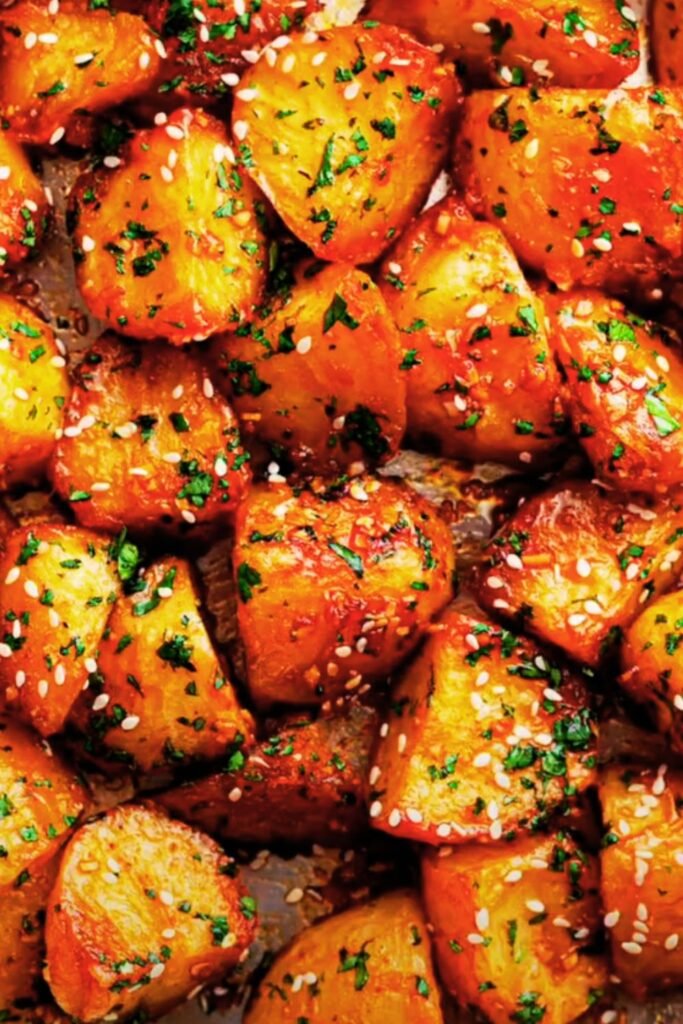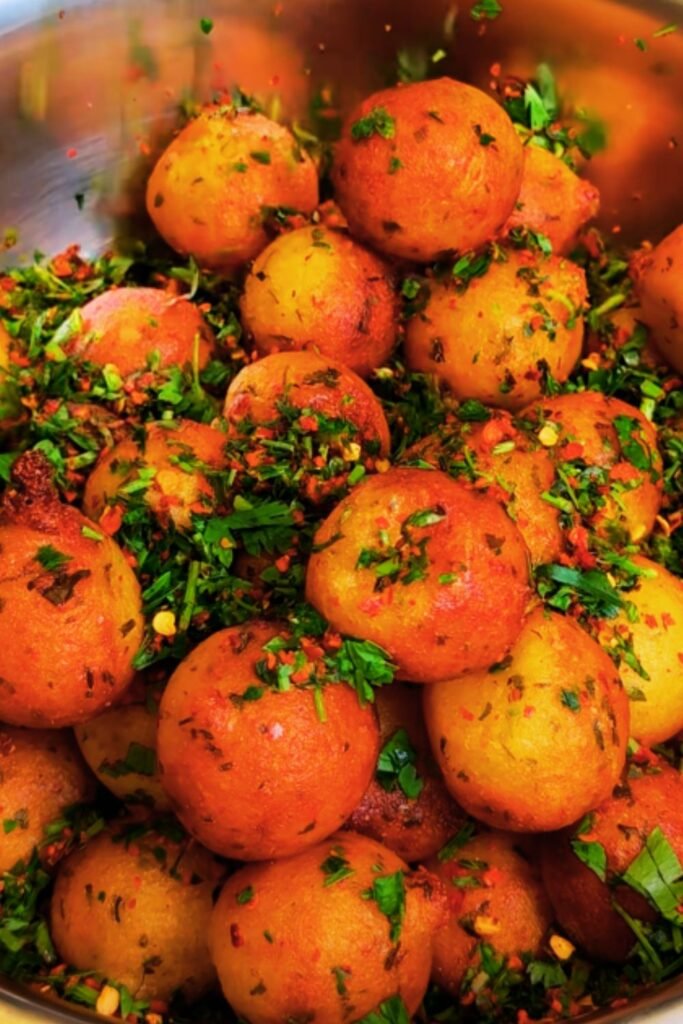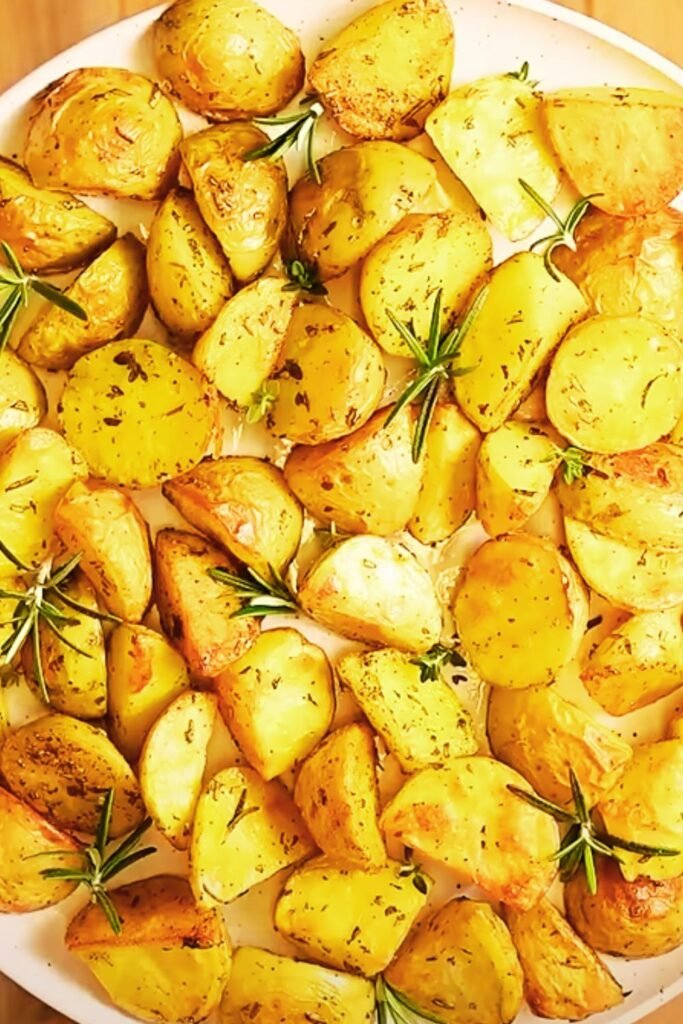When I first discovered the magic of combining crispy roasted potatoes with the sweet-spicy kick of sriracha glaze, my dinner game changed forever. These aren’t your ordinary roast potatoes – they’re a flavor-packed side dish that transforms any meal into something extraordinary. The sticky, caramelized exterior gives way to fluffy, tender potato flesh inside, while that distinctive sriracha tang keeps you coming back for more.
I’ve been perfecting this recipe for years, and I’m excited to share every secret with you. From choosing the right potato variety to achieving that perfect golden crust, I’ll guide you through creating roast potatoes that will have your family and friends begging for the recipe.
Understanding the Art of Sriracha Glazed Potatoes
Before we dive into the cooking process, let me break down what makes these potatoes truly special. The technique combines traditional roasting methods with Asian-inspired flavoring, creating a fusion dish that’s both familiar and exciting.
Key Components Defined
Sriracha Glaze : A sticky, sweet-spicy coating made from sriracha sauce, honey or brown sugar, and complementary seasonings that caramelizes during roasting
Parboiling : Pre-cooking potatoes in boiling water to partially cook the interior while roughing up the exterior for maximum crispiness
High-Heat Roasting : Cooking at temperatures between 425-450°F to achieve the perfect balance of crispy exterior and fluffy interior
Caramelization : The browning process that occurs when sugars in the glaze break down under heat, creating complex flavors and appealing color
The Science Behind Perfect Roast Potatoes
Understanding why certain techniques work helps you achieve consistent results every time. When I parboil potatoes before roasting, I’m accomplishing two crucial things: partially cooking the starch inside and creating a roughened surface that becomes incredibly crispy when roasted.
The high heat of the oven creates what food scientists call the Maillard reaction – that beautiful browning that develops complex, savory flavors. Meanwhile, the sriracha glaze undergoes caramelization, transforming from a liquid coating into a sticky, concentrated flavor bomb.
Choosing Your Potatoes: A Complete Guide
Not all potatoes are created equal for roasting. I’ve tested dozens of varieties over the years, and here’s what I’ve learned about selecting the perfect spuds for this recipe.
| Potato Variety | Starch Content | Best Use | Roasting Performance |
|---|---|---|---|
| Russet Burbank | High (22%) | Excellent for fluffy interior | Outstanding – creates the fluffiest centers |
| Yukon Gold | Medium (18%) | Great all-purpose choice | Very good – balanced texture and flavor |
| Red Pontiac | Low (16%) | Good for firm texture | Good – holds shape well but less fluffy |
| Fingerling | Medium-Low (17%) | Specialty presentation | Fair – better for whole roasting |
| Baby Potatoes | Variable | Convenience option | Good – no cutting required |
My personal preference? Russet potatoes for their incredible fluffiness, though Yukon Golds run a close second for their buttery flavor and golden color.

Essential Equipment and Ingredients
Having the right tools makes this recipe foolproof. I’ve learned through experience that certain equipment choices can make or break your results.
Must-Have Equipment
- Large, heavy-bottomed roasting pan: Ensures even heat distribution
- Fine-mesh strainer: For draining parboiled potatoes thoroughly
- Large mixing bowl: For tossing potatoes with glaze
- Sharp chef’s knife: For uniform potato cutting
- Kitchen thermometer: To verify oil temperature
Ingredient Breakdown
| Ingredient | Quantity | Purpose | Substitution Options |
|---|---|---|---|
| Russet Potatoes | 2.5 lbs | Base ingredient | Yukon Gold, Red potatoes |
| Sriracha Sauce | 1/4 cup | Primary flavor | Gochujang, Sambal Oelek |
| Honey | 3 tablespoons | Sweetness/glazing | Brown sugar, Maple syrup |
| Soy Sauce | 2 tablespoons | Umami depth | Tamari, Coconut aminos |
| Rice Vinegar | 1 tablespoon | Acidity balance | Apple cider vinegar |
| Sesame Oil | 1 tablespoon | Nutty flavor | Peanut oil, Vegetable oil |
| Garlic | 4 cloves | Aromatic base | Garlic powder (1 tsp) |
| Fresh Ginger | 1 tablespoon | Warming spice | Ground ginger (1 tsp) |
| Vegetable Oil | 1/4 cup | Roasting medium | Canola oil, Avocado oil |
| Salt | 2 teaspoons | Seasoning | Sea salt, Kosher salt |
The Complete Sriracha Glazed Roast Potatoes Recipe
Now comes the exciting part – putting it all together. I’ve refined this method through countless batches, and each step serves a specific purpose in achieving potato perfection.
Preparation Phase (15 minutes)
First, I preheat my oven to 450°F. This high temperature is crucial for achieving that coveted crispy exterior. While the oven heats, I wash and peel 2.5 pounds of russet potatoes, then cut them into uniform 2-inch chunks. Consistency in size ensures even cooking – I’ve learned this lesson the hard way after serving batches with some pieces perfectly done and others still hard in the center.
Next, I bring a large pot of salted water to a rolling boil. The salt isn’t just for flavor; it helps the potato surfaces become slightly rougher during parboiling, which translates to better crisping later.
Creating the Perfect Glaze
While the water heats, I whisk together my sriracha glaze in a large mixing bowl. I combine 1/4 cup sriracha sauce, 3 tablespoons honey, 2 tablespoons soy sauce, 1 tablespoon rice vinegar, 1 tablespoon sesame oil, 4 minced garlic cloves, and 1 tablespoon freshly grated ginger.
The key to a great glaze is balance. I taste as I go, adjusting sweetness with more honey if the heat is too intense, or adding extra sriracha if I want more fire. Remember, the flavors will concentrate as the glaze caramelizes in the oven.
The Parboiling Process
Once my water reaches a vigorous boil, I carefully add the potato chunks. I set my timer for exactly 8 minutes – not a second longer. Overparboiling creates mushy potatoes that fall apart during roasting, while underparboiling doesn’t create enough surface roughness for optimal crisping.
During these 8 minutes, I heat 1/4 cup vegetable oil in my roasting pan in the preheated oven. Hot oil is essential for immediate searing when the potatoes hit the pan.

The Critical Draining and Roughening Step
When the timer rings, I immediately drain the potatoes in a fine-mesh strainer. Here’s where many people go wrong – they don’t dry the potatoes thoroughly. Excess moisture is the enemy of crispiness. I shake the strainer vigorously and even give the potatoes a few good tosses to rough up their surfaces further.
The potatoes should look slightly fuzzy around the edges. This roughened surface area will become incredibly crispy when it hits the hot oil.
Glazing and Initial Roasting
I transfer the hot, drained potatoes directly to my bowl of sriracha glaze. Working quickly, I toss everything together until each piece is completely coated. The residual heat from the potatoes helps the glaze penetrate slightly into those roughened surfaces.
Carefully removing my roasting pan from the oven (that oil is scorching hot!), I add the glazed potatoes in a single layer. The satisfying sizzle tells me everything’s working correctly. I immediately return the pan to the oven.
The Roasting Timeline
| Time | Temperature | Action | Visual Cue |
|---|---|---|---|
| 0-20 min | 450°F | Initial roasting | Edges begin browning |
| 20-25 min | 450°F | First flip | Golden brown on bottom |
| 25-40 min | 450°F | Continue roasting | Deep golden all over |
| 40-45 min | 450°F | Final check | Caramelized glaze coating |
The first 20 minutes are crucial – I resist the urge to peek or move anything. The potatoes need uninterrupted time to develop that initial crust. At the 20-minute mark, I flip each piece using tongs, revealing beautifully golden-brown bottoms.
Achieving the Perfect Finish
The final 20-25 minutes transform good roast potatoes into extraordinary ones. The sriracha glaze caramelizes into a sticky, lacquered coating that clings to every crispy surface. I know they’re done when the glaze has darkened to a rich amber color and the potatoes sound hollow when tapped with a fork.

Advanced Techniques and Variations
After mastering the basic recipe, I’ve developed several variations that keep this dish exciting. Each modification brings something unique to the table while maintaining the core appeal of crispy, glazed potatoes.
Spice Level Modifications
Mild Version: Reduce sriracha to 2 tablespoons and add 1 tablespoon tomato paste for color and sweetness Extra Hot: Add 1-2 teaspoons sambal oelek or fresh minced chilies to the glaze Smoky Heat: Replace 1 tablespoon sriracha with chipotle paste for a smoky dimension
Flavor Variations
Korean-Inspired: Replace honey with gochujang and add toasted sesame seeds Thai-Style: Use sweet chili sauce instead of honey and add lime zest Japanese Twist: Include miso paste and mirin for umami depth
Nutritional Information and Dietary Considerations
Understanding the nutritional profile helps you incorporate these potatoes into a balanced meal plan. I’ve calculated the values based on my standard recipe serving 6-8 people.
| Nutrient | Per Serving | % Daily Value | Health Benefits |
|---|---|---|---|
| Calories | 285 | 14% | Energy from complex carbs |
| Carbohydrates | 52g | 17% | Sustained energy release |
| Protein | 6g | 12% | Muscle maintenance |
| Fat | 8g | 12% | Essential fatty acids |
| Fiber | 4g | 16% | Digestive health |
| Potassium | 890mg | 25% | Heart health, blood pressure |
| Vitamin C | 28mg | 31% | Immune system support |
| Vitamin B6 | 0.8mg | 47% | Brain function |
Dietary Adaptations
Vegan: Replace honey with maple syrup or agave nectar Gluten-Free: Ensure your soy sauce is gluten-free (use tamari) Lower Sodium: Reduce soy sauce by half and increase other seasonings Whole30: Replace honey with date paste and use coconut aminos instead of soy sauce
Serving Suggestions and Meal Pairings
These sriracha glazed potatoes are incredibly versatile. I’ve served them alongside everything from simple grilled chicken to elaborate holiday feasts. The sweet-spicy profile complements both Asian and Western cuisines beautifully.
Perfect Protein Pairings
Grilled Meats: The glaze’s acidity cuts through rich, fatty cuts like pork shoulder or beef short ribs Roasted Chicken: Classic comfort food combination with an exciting twist Salmon: The sweetness balances the fish’s natural oils perfectly Tofu or Tempeh: Creates a completely plant-based meal with complementary flavors
Vegetable Companions
Steamed Broccoli: Simple preparation lets the potatoes shine Asian Slaw: Adds refreshing crunch and continues the flavor theme
Roasted Brussels Sprouts: Another caramelized vegetable for textural variety Stir-Fried Green Beans: Quick cooking preserves vibrant color and crispness
Complete Meal Ideas
Weeknight Dinner: Sriracha potatoes + grilled chicken thighs + steamed broccoli Weekend BBQ: Serve alongside grilled meats and corn on the cob Holiday Side: Elevates traditional roast dinners with unexpected flavor Potluck Contribution: Always disappears first and generates recipe requests
Storage, Reheating, and Meal Prep
One of my favorite aspects of this recipe is how well it scales and stores. I often make double batches because the leftovers are nearly as good as the original – sometimes better as the flavors have time to meld.
Proper Storage Methods
Refrigeration: Store in airtight containers for up to 4 days Freezing: While possible, texture changes significantly – best enjoyed fresh Room Temperature: Safe for up to 2 hours before requiring refrigeration
Reheating Techniques
| Method | Temperature | Time | Result Quality |
|---|---|---|---|
| Oven Reheat | 375°F | 10-15 min | Excellent – restores crispiness |
| Air Fryer | 350°F | 5-8 min | Outstanding – like fresh made |
| Stovetop | Medium heat | 8-10 min | Good – requires stirring |
| Microwave | High power | 2-3 min | Fair – loses crispiness |
I always recommend the oven or air fryer method. A quick blast of high heat revives that crispy exterior beautifully. Sometimes I even add a light brush of fresh glaze before reheating for extra shine and flavor.
Meal Prep Strategies
Partial Prep: Parboil and glaze potatoes the night before, then roast when needed Full Prep: Complete the recipe and reheat portions throughout the week Batch Cooking: Make multiple flavor variations and freeze in meal-sized portions Component Prep: Make extra glaze to use on other vegetables or proteins
Troubleshooting Common Issues
Even with detailed instructions, sometimes things don’t go perfectly. I’ve encountered every possible potato disaster over the years, so let me share solutions to the most common problems.
Problem-Solution Guide
Soggy Potatoes
- Cause: Insufficient drying after parboiling or overcrowded pan
- Solution: Always dry thoroughly and use a larger roasting pan
- Prevention: Single layer arrangement with space between pieces
Burnt Glaze
- Cause: Oven temperature too high or glaze too sugary
- Solution: Reduce temperature to 425°F and tent with foil if needed
- Prevention: Monitor closely during final 15 minutes
Uneven Cooking
- Cause: Inconsistent potato sizes or uneven oven heat
- Solution: Cut more uniformly and rotate pan halfway through
- Prevention: Use a ruler for consistent 2-inch pieces
Lack of Crispiness
- Cause: Wet potatoes or insufficient oil temperature
- Solution: Ensure oil is sizzling hot before adding potatoes
- Prevention: Heat oil in oven while preparing other components
Questions & Answers
Q: Can I make these potatoes ahead of time for a dinner party? I absolutely understand the desire to prep ahead for entertaining! You can partially prepare these by completing the parboiling and glazing steps earlier in the day. Store the glazed, uncooked potatoes in the refrigerator, then roast them fresh when your guests arrive. This actually works beautifully because the glaze has more time to penetrate the potato surfaces. Just add an extra 5-10 minutes to the cooking time since they’ll be starting from cold.
Q: What’s the best way to adjust the spice level for different family members? This is such a common challenge in my household too! I recommend making the base recipe at a mild-medium heat level, then offering additional sriracha or chili oil on the side for those who want more fire. Alternatively, you can divide the batch after parboiling and create two different glaze intensities. The kids’ version might use only 2 tablespoons of sriracha with extra honey, while the adults’ version gets the full heat treatment.
Q: Why do my potatoes sometimes fall apart during roasting? Potato breakdown usually happens when they’re overparboiled or when using a variety that’s too starchy. I’ve found that keeping the parboiling time to exactly 8 minutes prevents this issue. Also, waxy varieties like red potatoes hold together better than russets, though they won’t get as fluffy inside. If you prefer russets for their texture, just be extra gentle when tossing them with the glaze.
Q: Can I use this glaze on other vegetables? Absolutely! This sriracha glaze is incredibly versatile. I’ve used it successfully on roasted Brussels sprouts, cauliflower, carrots, and even sweet potatoes. The cooking times will vary depending on the vegetable, but the technique remains the same. Root vegetables work particularly well because they caramelize beautifully with the glaze.
Q: How do I prevent the glaze from burning in a convection oven? Convection ovens cook about 25 degrees hotter than conventional ovens due to the fan circulation. I recommend reducing the temperature to 400°F and checking the potatoes every 15 minutes instead of 20. You might also want to position the rack in the lower third of the oven to prevent the tops from browning too quickly.
Q: What’s the secret to getting that restaurant-quality crispy exterior? The secret lies in three key steps that I’ve perfected over years of testing. First, parboiling creates the rough surface needed for maximum crispiness. Second, ensuring the potatoes are completely dry before adding the glaze prevents steaming. Third, starting with properly heated oil in the roasting pan creates immediate searing. Don’t skip any of these steps – they’re all crucial for achieving that professional-level crispiness.
Q: Can I make a larger batch for meal prep without compromising quality? Definitely! I regularly make double or triple batches for meal prep. The key is using multiple roasting pans to avoid overcrowding, which would cause steaming instead of roasting. I also rotate the pans’ positions in the oven halfway through cooking to ensure even browning. The larger batches actually work great because you can create different spice levels simultaneously.
Q: How do I know when the potatoes are perfectly done? Perfect doneness combines visual and audio cues that I’ve learned to recognize. Visually, the glaze should be deeply caramelized to an amber color with some darker edges. The potatoes should be golden brown all over with a glossy finish. Audibly, they should sound hollow when tapped with a fork, and you should hear a slight sizzle when you move them in the pan. If you’re still uncertain, pierce one with a knife – it should slide through effortlessly.
These sriracha glazed roast potatoes have become one of my signature dishes, and I hope they bring the same joy to your kitchen that they’ve brought to mine. The combination of techniques might seem complex at first, but once you’ve made them a few times, the process becomes second nature. The results – crispy, caramelized, perfectly balanced potatoes – are absolutely worth the effort.
Remember, cooking is as much about intuition as it is about following recipes. Taste your glaze, adjust the seasonings to your preference, and don’t be afraid to make this recipe your own. Whether you’re serving them as a weeknight side dish or the star of your next dinner party, these potatoes are guaranteed to impress.